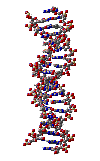|
Are you one of the few that respond to treatment for hepatitis C? part 2 (08/2003)
In patients being treated for hepatitis C the analysis of amino alanine transferase (ALT), a liver-produced enzyme, can help to predict if therapy will be successful, claims a team of researchers in the August issue of Hepatology2. The group of investigators propose that in some patients, it is possible, already in the first 48 hours of the one-year long treatment, to know its chances of success.
In healthy conditions ALT is present in low quantities in the blood. However, when liver injury occurs, cellular destruction results in the enzyme leaking into the blood and subsequent increase in its concentration. Because of this behaviour, ALT has been used for many years as a marker for liver disease. However, it is not an accurate diagnostic tool as many patients with abnormal liver biopsies present normal levels of ALT.
Still, it is crucial to understand ALT dynamics as variation in its concentration are a direct indicator of liver injury. And it is liver damage that leads to cancer or hepatic collapse, the real dangers of hepatitis C.
In this paper2 Ruy Ribeiro (Theoretical Biology and Biophysics Group, Los Alamos National Laboratory, New Mexico, USA) and Jennifer Layden-Almer (Department of Medicine, University of Illinois, Chicago, Illinois, USA) studied patients being treated for hepatitis C and discovered that they could be divided into four distinct groups according to the way their ALT levels fluctuate
The two investigators also show that patients in two of these groups are characterised by a decrease in ALT levels as the treatment proceed, and that this decrease directly correlates with the efficacy of the hepatitis C treatment.
This means, that patients identified through ALT analysis as belonging to any of these two subsets will have the higher chance of being successfully treated. And Ribeiro and Layden-Almer describe how this identification can be done already in the first 48 hours of treatment.
This is the first time that, not only, it has been shown that ALT dynamics in patients under treatment can be fitted into defined patterns, but also, that this can be used to predict the outcome of treatment as early as two days after the beginning of the one-year long therapy.
Furthermore Ribeiro and Layden-Almer describe that patients with normal ALT levels when treated can show a decrease in their viral load what means that they can respond to treatment. This is important information as treatment of these patients has been the object of heated debate.
The team of scientists write: “ALT changes during the first 48 hours of treatment were predictive of long-term response...” “our detailed ALT follow-up, albeit in a small sample, supports … that low ALT should not be the determinant factor in deciding to withhold therapy from HCV-infected patients”
Ribeiro and Layden-Almer’ work is important. In fact, only a relatively small percentage of patients respond to hepatitis C treatment and many suffer from extremely unpleasant side effects. This together with the fact that therapy is very expensive means that any information that could help to predict whether the treatment will be successful is extremely valuable.
Additionally, not only ALT detection has the potential of be a good diagnostic tool but it is also much easier and cheaper than the current analysis of the hepatitis genetic material (although one does not exclude the other).
2 Hepatology (2003) Jun; 38(2): 509-517
Authors’ contact
Dr. Ruy Ribeiro – ruy.ribeiro@zoology.ox.ac.uk
|
In collaboration with the Observatório da Ciência e do Ensino Superior (OCES)
Financed by the Fundação para a Ciência e Tecnologia (FCT) |





